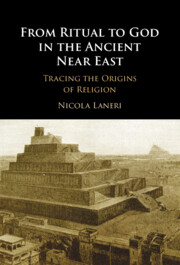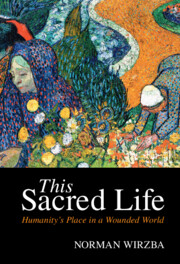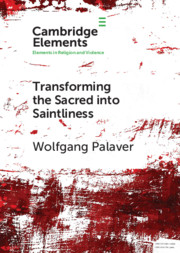Refine search
Actions for selected content:
29 results

The Theology of the Book of Leviticus
-
- Published online:
- 18 July 2025
- Print publication:
- 07 August 2025
3 - Toleration, Time, and the Other
-
- Book:
- Constitutional Intolerance
- Published online:
- 09 January 2025
- Print publication:
- 23 January 2025, pp 35-50
-
- Chapter
- Export citation
The sacred dimensions of the BRI’s infrastructural commons
-
- Journal:
- Modern Asian Studies / Volume 58 / Issue 5 / September 2024
- Published online by Cambridge University Press:
- 09 June 2025, pp. 1259-1275
- Print publication:
- September 2024
-
- Article
-
- You have access
- Open access
- HTML
- Export citation
2 - On Being Religious without Knowing It
-
- Book:
- Conversations with the Turtles
- Published online:
- 26 September 2024
- Print publication:
- 13 June 2024, pp 5-17
-
- Chapter
- Export citation

From Ritual to God in the Ancient Near East
- Tracing the Origins of Religion
-
- Published online:
- 03 May 2024
- Print publication:
- 09 May 2024
Security, Society, and the Perennial Struggles over the Sacred: Revising the Wars of Religion in International Relations Theory
-
- Journal:
- International Organization / Volume 78 / Issue 2 / Spring 2024
- Published online by Cambridge University Press:
- 06 August 2024, pp. 224-258
- Print publication:
- Spring 2024
-
- Article
-
- You have access
- Open access
- HTML
- Export citation
Chapter 3 - Haptic Colour: Experiential Viewing in Graeco-Roman Sacred Spaces
-
-
- Book:
- Senses, Cognition, and Ritual Experience in the Roman World
- Published online:
- 04 January 2024
- Print publication:
- 25 January 2024, pp 89-117
-
- Chapter
-
- You have access
- Open access
- HTML
- Export citation
Chapter 18 - Sunday Sports and the Re/constitution of the Christian Community and the Social Order
- from Holy Times
-
- Book:
- On Laudianism
- Published online:
- 05 October 2023
- Print publication:
- 19 October 2023, pp 235-245
-
- Chapter
- Export citation
War and Peace: Orthodox Icons and Putin's Politics of the Sacred
-
- Journal:
- Slavic Review / Volume 82 / Issue 2 / Summer 2023
- Published online by Cambridge University Press:
- 01 November 2023, pp. 447-473
- Print publication:
- Summer 2023
-
- Article
-
- You have access
- Open access
- HTML
- Export citation
Chapter 26 - Georg Trakl (1887–1914)
- from Part III - Poets
-
-
- Book:
- A History of World War One Poetry
- Published online:
- 18 January 2023
- Print publication:
- 12 January 2023, pp 424-440
-
- Chapter
- Export citation
9 - Indigenous Governance
- from II - Public Authority
-
-
- Book:
- The Cambridge Legal History of Australia
- Published online:
- 04 August 2022
- Print publication:
- 18 August 2022, pp 186-224
-
- Chapter
- Export citation
Chapter 6 - The Ascent of the Anthropoi: A Story
- from Part Two - One Anthropocene; Many Stories
-
-
- Book:
- Altered Earth
- Published online:
- 24 March 2022
- Print publication:
- 31 March 2022, pp 147-159
-
- Chapter
- Export citation

Purity and Pollution in the Hebrew Bible
- From Embodied Experience to Moral Metaphor
-
- Published online:
- 24 December 2021
- Print publication:
- 18 November 2021
AFTER SOVEREIGNTY? - Sovereignty and the Sacred: Secularism and the Political Economy of Religion. By Robert A. Yelle. Chicago: University of Chicago Press, 2018. Pp. 304. $100.00 (cloth); $32.50 (paper); $32.50 (digital). ISBN: 9780226585451.
-
- Journal:
- Journal of Law and Religion / Volume 36 / Issue 3 / December 2021
- Published online by Cambridge University Press:
- 17 December 2021, pp. 563-573
-
- Article
- Export citation
RELIGION AS THE CARNIVAL OF THE SECULAR: HISTORICIZING THE HISTORY OF RELIGIONS - Sovereignty and the Sacred: Secularism and the Political Economy of Religion. By Robert A. Yelle. Chicago: University of Chicago Press, 2018. Pp. 304. $100.00 (cloth); $32.50 (paper); $32.50 (digital). ISBN: 9780226585451.
-
- Journal:
- Journal of Law and Religion / Volume 36 / Issue 3 / December 2021
- Published online by Cambridge University Press:
- 22 November 2021, pp. 533-537
-
- Article
- Export citation
SPIRITUAL ECONOMY - Sovereignty and the Sacred: Secularism and the Political Economy of Religion. By Robert A. Yelle. Chicago: University of Chicago Press, 2018. Pp. 304. $100.00 (cloth); $32.50 (paper); $32.50 (digital). ISBN: 9780226585451.
-
- Journal:
- Journal of Law and Religion / Volume 36 / Issue 3 / December 2021
- Published online by Cambridge University Press:
- 27 October 2021, pp. 547-551
-
- Article
- Export citation
5 - Why Sacred Anything?
- from Part III - This Sacred Life
-
- Book:
- This Sacred Life
- Published online:
- 08 October 2021
- Print publication:
- 14 October 2021, pp 125-154
-
- Chapter
- Export citation

This Sacred Life
- Humanity's Place in a Wounded World
-
- Published online:
- 08 October 2021
- Print publication:
- 14 October 2021

Transforming the Sacred into Saintliness
- Reflecting on Violence and Religion with René Girard
-
- Published online:
- 30 December 2020
- Print publication:
- 04 February 2021
-
- Element
- Export citation
6 - What’s in a Name?
-
-
- Book:
- The Cambridge Handbook of Social Theory
- Published online:
- 03 December 2020
- Print publication:
- 17 December 2020, pp 103-123
-
- Chapter
- Export citation
